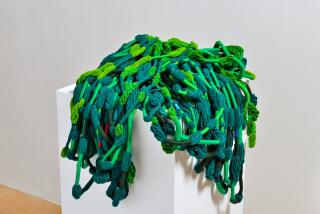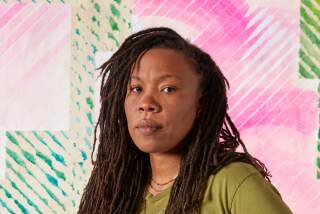Nora Ezell, 90; renowned for narrative quilts
- Share via
Anybody who asked Nora Ezell what inspired the scenes in her narrative quilts probably heard her usual response:
“I grab things off the top of my head and run with ‘em,” she often said. “I can’t tell you no more. I just do it.”
Anybody who saw Ezell’s quilts learned the rest. The quilts speak about the life of the Rev. Martin Luther King Jr., the civil rights era in Alabama, the saga of the American Indian.
Installed in museums and private collections throughout the country, the hand-sewn quilts are history rendered in cloth and thread. They are also a record of the life of the artist who sewed her memories, values and vision -- “a part of me,” she often said -- in every quilt.
Ezell, whose quilts won her a National Heritage Fellowship from the National Endowment for the Arts in 1992, died Sept. 6 from complications of heart disease in Tuscaloosa, Ala., at the home of a granddaughter. She was 90.
“Nora didn’t invent the narrative quilt, but I think she really made a significant contribution to that form,” said Gail Andrews, director of the Birmingham Museum of Art and a longtime friend. “She had a great way of communicating a story, a personality, an event.”
And her quilts were bold statements of creative freedom. A self-taught artist, Ezell used mixed media and vibrant colors, often working without patterns. She was a master of embroidery and applique.
Not all of Ezell’s quilts were the pictorial narrative or “storytelling” quilts, which include renderings of people, places and things, done in cloth and other materials. But all of the work embodies her unique aesthetic.
“She would take something very traditional and then make it her own,” said Joey Brackner, a folklorist for the Alabama State Council on the Arts.
Quilting was woven into all the other parts of Ezell’s life: marriage, motherhood, work, spirituality.
Ezell was born in Brooksville, Miss., on June 24, 1917, one of 10 children, and moved with her family to Alabama at a young age. Her mother was an expert seamstress who taught her daughters to sew their own clothes.
In those early days, Ezell learned that quilts could be made from scraps of anything; an aunt made hers from feed and flour sacks and stuffed them with cotton salvaged from the fields they worked.
Married at an early age, Ezell had one daughter, Annie Ruth Phillips. After her first husband died and her daughter was grown, Ezell remarried and moved to Paterson, N.J., where for years she worked in factories making drapery, upholstery, lingerie and other clothing. On the side, she continued quilting.
In 1979, after Ezell’s daughter was diagnosed with cancer, Ezell and her husband moved to Greene County, Alabama, to be near her. One day at a craft fair, the two women saw a storytelling quilt that sparked their interest. Eventually, mother and daughter began a quilt illustrating the life of King.
“She taught me a lot about colors,” Ezell said of her daughter. “She could see so straight, she would help me get seams and cut pieces very straight, which is very important in making a quilt.”
But Ezell’s daughter never had an opportunity to see the finished King quilt; she died in 1984. Devastated, Ezell could no longer work on the quilt. When she returned to the project, it took her two years to finish.
“I don’t try to be perfect,” she told a writer for the Atlanta Journal-Constitution in 1999. “Nobody’s perfect but God. But I want to do as good as I can.”
In making the quilt, Ezell drew on her memories of the civil rights era, as she would for other quilts. In 1986 the King quilt was included in a national exhibition called “Stitching Memories: African American Story Quilts” organized by Williams College in Massachusetts.
The exhibition was a turning point for Ezell. Later she received commissions, her work received gallery and museum showings, and her acclaim grew. And Ezell was the recipient of the 1990 Alabama Folk Heritage Award.
Her quilts, which sold for about $7 in the 1950s, were considered art worth thousands of dollars each by the 1990s.
Each time Ezell created a quilt, she kept a journal with entries that included her thoughts, the hours spent each day on the piece, the cost of materials.
The journal was a record of the birth of a quilt and allowed her to speak with specificity about her work. She knew, for example, that a quilt illustrating Bible stories took 1,800 hours to complete.
Still, such accounting was sometimes incomplete because some expenditures -- such as the pain of remembering -- were impossible to tally.
“I do not find it easy to work on this quilt, somehow the hurt is still there,” read a journal entry made while Ezell worked on a quilt she called “A Tribute to Civil Righters of Alabama,” which now hangs in the Birmingham Civil Rights Institute.
Along with the struggles of completing a quilt, Ezell, like 19th century women diarists, also wrote “about her health, her house, an errant grandchild,” said Andrews, the Birmingham Museum of Art’s director. “There was this personal story of hers woven into her daily work.”
On Monday, May 4, 1981, while creating a breathtaking “Broken Star” quilt, she wrote in her journal:
“Love this quilt, it is beautiful. Hope I can sell it, don’t care if I don’t. (Smile) Cil is graduating the 7th of June, David graduated the 21st of May, Mike is getting married the 20th of June. I’ll have a birthday the 24th, Ruth the 28th, Mama died the 9th, 1958, so many things to remember.”
Deeply devoted to her family, Ezell often gave quilts as gifts.
“When you got married, everybody got a quilt,” said Ezell’s granddaughter Beverly Smith.
In addition to Smith, Ezell is survived by granddaughter Audrey Williams and a grandson, A.C. Jackson, both of Tuscaloosa, Ala.; another grandson, David Phillips of Melbourne, Fla.; six siblings; seven great-grandchildren; and 11 great-great-grandchildren.
The quilts were a way for Ezell to celebrate, remember and sometimes explore. On April 13, 1993, while creating “The American Indian’s Saga (as I see them),” Ezell wrote:
“Got started on this quilt at 11:15. . . . So many things I identify with the telling of this story. My great-grandfather on my father’s side was a Black Creek Indian. I love their life story [Indians, I mean.]”
Though her journal was written for her family, it was published in 1999 by Black Belt Press as “My Quilts and Me: The Diary of an American Quilter.” Ezell was as candid and feisty in her writing as she was in person, speaking about her faith in God, the difficulties of her craft, and of aging. Until shortly before her death she was still quilting, “cutting the grass . . . fixing a leak; you name it, she could claim it,” Smith said.
Though Ezell worried about workmanship and waning energy, she never seemed to run short of themes for her narrative quilts. Life had offered a sufficient supply: “I have so many memories of the civil rights movement,” she often said, “I could make a quilt from Birmingham to Selma.”
“I always loved that: from Birmingham to Selma,” Andrews said. “I can see her quilting all the way.”
Memorial donations may be sent to Hospice of West Alabama, 3851 Loop Road, Tuscaloosa, AL 35404
--
More to Read
The biggest entertainment stories
Get our big stories about Hollywood, film, television, music, arts, culture and more right in your inbox as soon as they publish.
You may occasionally receive promotional content from the Los Angeles Times.










